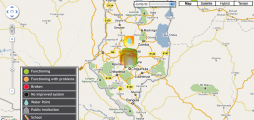Roughly 13 percent of the world’s population still lacks access to a regular supply of clean drinking water, and monitoring current water pumps and sanitation points is an important part of making sure that areas that have gained access to clean water don’t lose it. Water for People is a non-profit organization that monitors water and sanitation points in the developing world; last February, the organization began to investigate how mobile technology could help their work and from this, FLOW was born.
FLOW (Field Level Operations Watch) is an open-source, Android application that allows field workers to use mobile phones to document how well water pumps and sanitation points in the developing world are functioning, then transmit that data to create an online tagged map of target regions.
Developed as a branching survey, FLOW collects data so that researchers and development workers can track and analyze trends over time. Written in Java, the application allows fieldworkers to collect data on the state of water pumps in rural areas and immediately transmit that information to an online map so that there are real-time data updates. Developer Dru Borden of Gallatin Systems, who designed FLOW, says that the system was designed to work on versions 1.6 and greater for Android phones, as FLOW requires GPS and photo-tagging capabilities.
Initially launched with a small pilot in Honduras last May, FLOW’s first big test was in Rwanda. According to Kerri Kugler, senior manager of programmatic data at Water for People, Rwanda was chosen as the second pilot because it would be both large-scale and would test how well the system could work in areas of limited network coverage. After the pilot proved the system worked, FLOW began its official roll out in October to seven more countries in which Water for People operates (Malawi, Guatemala, Bolivia, El Salvador, Nicaragua, Peru, and India).
FLOW is Water for People’s first foray into using mobile technology in their data collection work. Kugler explains, “It very quickly came to be clear that mobile technology was the way to go, [...] the wonderful thing about mobile devices and the Android platform was that it was very open, nonproprietary and very affordable.”
She explains that open-source mobile technology was not only chosen because of the ease of recording, transmitting, and analyzing data, but also because by putting information online, it creates transparency in the monitoring process. She says, “It really comes down to a question of monitoring your work and being transparent. We really believe that it's important to monitor your work and make sure what you're doing is actually working - and if it's not working, then to find out why and make changes to your program.” As such, having real-time data on water pump functionality ensures that negative trends are noticed more quickly than traditional hand-recorded methods.
All the data collected on FLOW by field workers is stored on remote servers; the Amazon cloud for images and the Google cloud for maps and all other data. According to Borden, this was done to both keep costs down (Kugler estimates that FLOW’s data storage fees cost Water for People less than $3 U.S. per month) and to avoid the need to have an on-site IT specialist in each deployment area.
The system was designed to work either online or offline, so that if there isn’t a mobile or Wi-Fi connection, FLOW will hold its information and save it until the field worker can connect and upload it into the system. However Kugler says that mobile coverage has been much greater than originally anticipated. She says, “We have been really surprised – we thought a lot of the places we work would have no cell connectivity and that we would be using that storage system quite a bit. But we actually found that, with a couple of exceptions in really rural areas in Bolivia and Malawi, for the most part there has been cell reception, so information has been transmitted as soon as it's collected. “
Borden agrees saying, “The biggest surprise has been how much real-time data we can get directly from the field. I thought that the networks would be a lot worse than they are."
Since its official launch in October 2010, the system has recorded information on more than 1100 water points around the world. Funded by Water for People, the organization provides Android phones with local SIM cards to field workers, who visit sites and report back on the quality of existing water and sanitation structures. Field workers can tag pumps as “functioning,” “functioning with problems,” “broken,” and “no improved system” to track which areas are most in need of services. The database also works as a means of mapping current systems, so that other organizations can easily see the water infrastructure of developing regions.
Kugler concludes, “We believe in taking risks and trying new things, and pushing ourselves forward as much as possible, but also pushing the water and sanitation field forward as much as possible.” Building a water source isn’t enough, making sure that local users have continued access to safe, clean water is the true sign of positive change.


Where is the source?
Water for People has been talking about how FLOW is Open Source for a while now, but there is no source available.
Can you either please provide a link to the source repository or stop using the term Open Source? It has a very specific meaning, and that meaning is that the source is freely available without signing any licenses or jumping through any hoops.
Thanks.
Post new comment